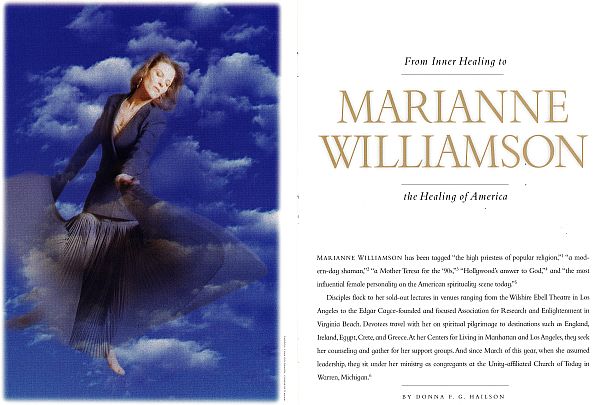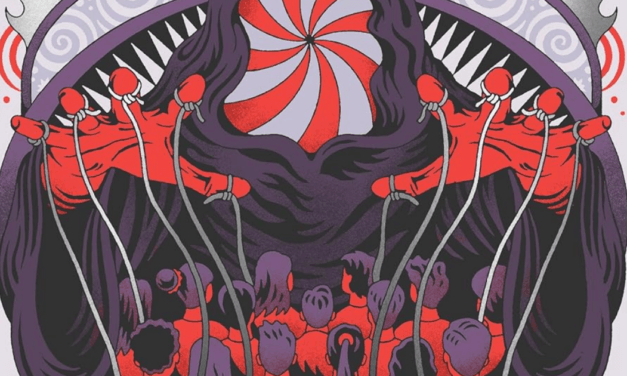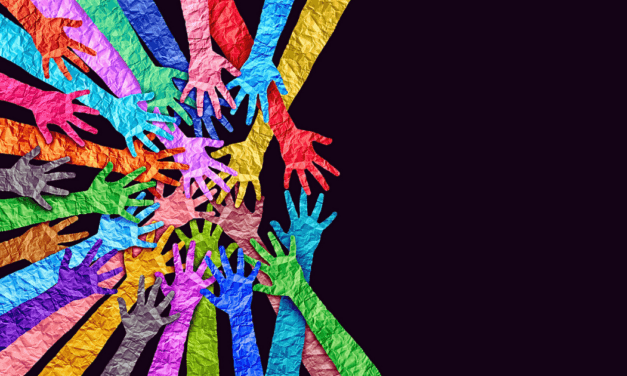This article first appeared in the CHRISTIAN RESEARCH JOURNAL, volume 21, number 2 (1998). For further information or to subscribe to the CHRISTIAN RESEARCH JOURNAL go to: http://www.equip.org/christian-research-journal
Marianne Williamson has been tagged “the high priestess of popular religion,”1 “a modern-day shaman,”2 “a Mother Teresa for the ‘90s,”3 “Hollywood’s answer to God,”4 and “the most influential female personality on the American spirituality scene today.”5
Disciples flock to her sold-out lectures in venues ranging from the Wilshire Ebell Theatre in Los Angeles to the Edgar Cayce-founded and focused Association for Research and Enlightenment in Virginia Beach. Devotees travel with her on spiritual pilgrimage to destinations such as England, Ireland, Egypt, Crete, and Greece. At her Centers for Living in Manhattan and Los Angeles, they seek her counseling and gather for her support groups. And since March of this year, when she assumed leadership, they sit under her ministry as congregants at the Unity-affiliated Church of Today in Warren, Michigan.6
Williamson burst onto the national scene in 1992 with her first book, A Return to Love: Reflections on the Principles of A Course in Miracles. The volume topped The New York Times best-seller list for 35 weeks and became 1992’s fifth largest non-fiction seller. Oprah Winfrey was so taken with the tome that she “gave it a grand Oprah-size plug on her syndicated talk show…announcing she’d personally bought 1,000 copies for distribution to the spiritually needy.”7
Williamson’s second book, A Woman’s Worth, also made a respectable showing, spending 19 weeks at the top of The New York Times list in 1994. In the succeeding years, she has produced scores of audio tapes (which are “traded like baseball cards among afficionados”8) and three more books: Illuminata: Thoughts, Prayers, Rites of Passage (1994); Emma and Mommy Talk to God (1996); and The Healing of America (1997). Her website, which is accessed simply by using her first name, tracks her movements, provides links to her friends’ websites, and moderates online discussion groups for facilitating “mind-heart connection” within social and political arenas.
Williamson rubs elbows with international glitterati from the Dalai Lama to Elizabeth Taylor, at whose most recent wedding she officiated. And, though it is only an Internet legend that Nelson Mandela quoted one of her prayers in his 1994 inaugural address,9 it is true that, in that same year, Bill and Hillary Clinton hosted Williamson and other New Age leaders at a Camp David retreat.10 Furthermore, when she visited the Taj Mahal, she chanced upon the Mufti, Egypt’s highest Muslim cleric, who invited her to a meeting at his hotel.
It has been quite the ride for the 46-year-old Houston native.
Marianne Williamson- GOD WAS “A CRUTCH” SHE DIDN’T NEED
Williamson was raised in a middle-class Jewish family. One of her friends told a Vanity Fair reporter that she was always “trying to get her family’s approval. She had a remote father and a disapproving mother…a double whammy.”11
Williamson claims that in 1965, when she was 13 years old, her father took her to Saigon so that she might see and understand war and not be convinced by the “military-industrial complex” propaganda that war was ok. The next crossroad in her life apparently came in high school, when she was exposed to philosophy and decided “God was a crutch” she didn’t need).12
She attended Pomona College, but left after two years to live in a commune. In retrospect, she admits. “Whatever sounded outrageous, I wanted to do. And usually, I did.”13 Over the years, she tried her hand at owning a New Age bookstore and working as a cocktail waitress and cabaret singer. She briefly tried marriage and then motherhood. She writes:
I went from relationship to relationship, job to job, city to city, looking for some sense of identity or purpose, some feeling that my life had finally kicked in….I went into therapy several times, but it rarely made an impact. I sank deeper and deeper into my own neurotic patterns, seeking relief in food, drugs, people, or whatever else I could find to distract me from myself. There was some huge rock of self-loathing sitting in the middle of my stomach during those years, and it got worse with every phase I went through. As my pain deepened, so did my interest in philosophy: Eastern, Western, academic, esoteric, Kierkegaard, the I Ching, existentialism, radical death-of-God theology, Buddhism, and more. I always sensed there was some mysterious cosmic order to things, but I could never figure out how it applied to my own life… By my mid-twenties, I was a total mess.14
And then in 1977, she came across “a self-study program of spiritual psychotherapy.” A Course in Miracles.15 (The Course encompasses three volumes: a textbook, workbook, and teacher’s manual. It claims to be the product of channeled communication received by the atheistic psychologist Helen Shucman. The Course purports to he a corrective to Christianity. In fact, it everts every foundational principle of the traditional faith. See accompanying article.)
Williamson was initially put off by the text. Her aversion stemmed from her discomfort with the book’s “Christian” terminology and arrogant tone. Within a year, however, she’d picked it up again, hoping it might hold some means of deliverance from the miasma that was her life. As her mother said at the time, she “read it like a menu.”16 The book, perhaps not so coincidentally, appeared on the scene at the same time as Williamson’s nervous collapse. She credits the intersection of the two with her “spiritual transformation”; “My fear finally became so great, that I wasn’t too hip to say, ‘God, please help me’….So I went through this grandiose, dramatic moment when I invited God into my life…It’s as though my life was a house [and]…as soon as I gave the house to God. He hit it with a giant wrecking ball.”17
One should note that the “God” to whom she had given herself bears no resemblance to the God of the Bible. Throughout all of her writings, Williamson actually appears quite confused and conflicted about the nature of her God. In one place she says, “It” is “a force” that loves, cares, and protects.18 In another place, she says, God is “an impersonal love for all life.”19 Elsewhere, she asserts, “He is the energy; the thought of unconditional love…God is love and He dwells within us.”° She describes human beings, in turn, as being “part of God,” the creations and extensions in the “mind” of an impersonal force or energy. “We were created in His image, or mind, which means that we are extensions of His love, or Sons of God.”21 Her view sometimes appears to approximate panentheism, the belief that we are all within God but that God is “more than everything, even as God is present everywhere.”22 But she’s never quite clear.
By 1983, Williamson managed to pull herself together enough to move to Los Angeles, where she took a job with the Philosophical Research Society. “Before long, she had begun to speak on A Course in Miracles. At first fifteen people would turn out, then forty; soon it was a hundred. She began renting spaces in churches, and her audience grew…[then in 1987] she started speaking in New York once a month as well.”23 In that same year, responding to a call for help from an ailing friend and using $50,000 in seed money from music mogul David Geffen, she opened the Los Angeles Center for Living, a nonprofit organization offering meals, housecleaning, counseling, and other services to those with “life-challenging illnesses.” Two years later, with another $50,000 from Geffen, she founded the Manhattan Center for Living.24
Following the publication in 1992 of A Return to Love, which she described as “Cliff Notes” on A Course in Miracles, she became a national celebrity in demand everywhere. She cranked out audiotapes on topics including communication, dealing with anger, death and dying, emotional healing, intimacy, meditation and prayer, money, simplicity, success, and work and career. She contributed to books edited by other New Age personalities and appeared in a 59-minute documentary, Quest: The Spiritual Path to Success.
More recently, Williamson has broadened her focus from personal transformation to global transformation — an attempt to awaken the United States to its supposed need to balance its overly “yang” externalized culture (of human assertion and physical manifestation) with an internalized “yin” activism (spirituality). This campaign to promote “holistic politics” finds her:
• leading a seminar in Greece to explore the origins of the Western world — its philosophy and spirituality;
• writing editorials on the differences between religious and spiritual politics;
• conducting prayer vigils for peace in Pakistan, India, and Iraq with other New Age leaders, such as Jerry Jampolsky (Teach Only Love), James Redfield (The Celestine Prophecy), and Neale Donald Walsch (Conversations with God);
• offering website links to organizations ranging from the Rainforest Action Network to the Natural Law Party, One World Online, and Jerry Brown’s We the People Page;
• encouraging the development of “Citizen Salons,” which call individuals together to discuss and visualize an improved world, keep informed about political issues, and lobby for change;
• moving away from her “self-help focus” to “healing within a community setting” by becoming the leader of the Church of Today in metro Detroit.25
Williamson’s evolution — from a focus on inner healing to an activism calling for a new paradigm of political understanding — mirrors the trajectory of the New Age movement. We can track the wider phenomenon as we follow her path from A Return to Love: Reflections on the Principles of A Course in Miracles to The Healing of America.
Marianne Williamson- HOLDING A MIRROR TO THE NEW AGE: IF IT DOESN’T EXIST, IT CAN’T HURT YOU
Marianne Williamson opens A Return to Love by declaring that each human being is born with a natural tendency to focus on love, but something goes immediately wrong with that programming. The individual is taught to “think unnaturally,” to fear, “to think thoughts like competition, struggle, sickness, finite resources, limitation, guilt, bad, death, scarcity and loss.”26 The goal of life for each of us thus becomes the retrieval of what was lost: the return to love. This love, which she identifies as both a co-creation with God and, at the same time, God, must he perceived, she says, via the vision of the “Third Eye,” which she equates with the “Holy Spirit” and the “Higher Self.”27
All that exists, all that is real, she asserts, is this love. Everything else is illusion. Thus all is one and all is God. “We [only] think we’re separate because we have bodies, when in truth, we have bodies because we think we are separate.”28
Williamson elaborates on this by playing off of Carl Jung’s notion of the “collective unconscious” to posit the existence of a divine or Christ mind shared by all that exists. She concludes, “There’s only one of us here…like spokes on a wheel, all radiating out from the same center…[we’re] ‘sunbeams’ thinking we’re separate from the sun, or waves thinking we’re separate from the ocean… [when, instead, we are] one indivisible divine mind…holy beings, individual cells in the both of Christ.”29
In Williamson’s thinking, “the perfect you is the love within you. Your job is to allow the Holy Spirit to remove the fearful thinking that surrounds your perfect self…to remember that you are part of God…[and that] God is totally approving and accepting of you exactly as you are…You were not created in sin: you were created in love.”30 Heaven equals love in your mind. Hell equals fear in your life. Heaven is reality: hell is illusion. “Deliver me from hell” means “Deliver me from my insane thoughts.”31 Therefore, for Williamson, “accepting the Christ” becomes a correction in perception, an awakening from “the dream that we are finite, isolated creatures… [and acceptance of] the beauty within me as who I really am.”32
Everything, according to Williamson, can be made well through this divine/human will. Williamson thus denies the concept of sin and dismisses the need for a savior. In the place of universal sin, she posits universal illusion. While denying that any religion has a monopoly on the truth, she sets herself up as the arbiter of truth, and so establishes her own monopoly, effectively presenting herself as the savior.
Given a glimpse into the author’s psychic world, one cannot but note how desperately Williamson herself is still in need of personal release. She insists that everyone is terrified by internal oppression, free-floating fear, and self-loathing. Everyone is sabotaging everything, and everyone is wallowing in personal and collective hells of neuroses, addictive behaviors, depressions, illnesses, violent relationships, compulsions, and post-adolescent angst.
Williamson details her own search for routes out of this miry mess that is her life, recounting her journey through positive thinking, therapy, and 12-step programs. When all is said and done, she is evidently still burdened by the garbage of her life and has found no place to unload. She reaches a point where she seems to conclude that the only recourse is to deny the reality of the whole mess, saying, in effect, “If I don’t believe it exists, it can’t hurt me.”
She seems unaware of the inconsistencies in her system. The “God” she imagines comes across as a conflicted mass of illusions and identity problems. It’s not surprising to find Williamson suggesting that “in the world to come,” psychotherapy will be used more frequently, “not as crisis counseling, but as maintenance procedure…a valuable tool for staying sane.”33 This “God” that Williamson creates mirrors the self that is Williamson, and this “god” needs salvation, not just perpetual therapy.
Williamson says that “God’s plan for the salvation of the world is to heal it through the power of love. This “healing” comes, she says, when we realize there is no guilt in anyone, when we see through the illusion to the innocence, and when we consciously decide to focus on love and let the rest go. “If a person behaves unlovingly…their behavior was derived from fear and doesn’t actually exist. They’re hallucinating. You forgive them, then, because there’s nothing to forgive.”34 With what apparent ease she dismisses the evils of the world with these words!
Yet if all evil is illusion, then it follows that atonement is simply the correction of one’s perception. The significance of the Crucifixion and the Resurrection are lost on her as she identifies the first as “the energy pattern of fear” and the latter as “the energy pattern of love, which transcends the fear by replacing it.”35 “The message of the resurrection,” she asserts, “is that the crucifixion never occurred, except in our minds.”36
Later, she contradicts her denial of evil by insisting that the United States must make amends for the violation of sacred principles in dealing with nations such as Vietnam, and a huge apology is owed to Black Americans. But if there is no sin and evil is an illusion, then why do we need to apologize? Like Jesus and other “wayshowers and spiritual masters,” why can’t we, as she suggests, simply reach for “the total actualization of the Christ mind,” “see as God sees,” and thus “atone for our errors in perception”?37
Williamson presents us with another nonsensical contradiction when she states that we are not different but we’re just alike, we’re unique but we’re not special. We can’t be special, she says, because special people would be different.38
She further concludes that relationships are eternal, karmically connected assignments. She says this after insisting there can be no such thing as reincarnation because linear time does not exist.
Williamson asserts that “disease is loveless thinking materialized.” A person who is ill only thinks he or she is ill. Therefore, illness equals separation from God, and healing comes not from pills but from belief. But it is “okay to take medicine,” she says, “because the Holy Spirit enters our lives at our present level of consciousness.” It was different for Jesus, of course, because “Jesus did not believe in leprosy. Since all minds are connected, in his presence the leper no longer believed in it either. And so the leper was healed.”39
It probably serves no purpose to ask what happened when the leper left Jesus’ presence. Williamson would assert that because all minds are connected. Jesus never really left his presence. But, then, if we all can be healed simply by being in the presence of one who doesn’t believe in illness, and if we all are connected and sin and death are illusions, aren’t we still connected and consequently shouldn’t we all be healed? Williamson would probably argue that this is the point of critical mass: healing comes when the scales tip so that there are more people disbelieving the illusion than believing the illusion. Of course, she has no proof for any of this.
She goes on to suggest that AIDS patients should employ “enlightened visualizations” to effect healing: “Imagine the AIDS virus as Darth Vader, and then unzip his suit and allow an angel to emerge.” Or, she suggests, people might write letters to their AIDS or cancer, relating their feelings about the illness and seeing sickness as “our own love that needs to be reclaimed.” Williamson insists this is “a more positive approach to healing than is seeing the sickness as something hideous we must get rid of.”40
Sickness equals love that needs to be reclaimed? How irresponsible and cruel! We do know that bodily health can at times be affected by our state of mind. But, by dismissing the reality of viruses and toxins, she effectively blames each individual for any illness he or she is suffering.
In fact, in A Return to Love, Williamson illuminates many of the principles of the New Age, including the belief that only one substance (God) exists and that all apparent separations are illusions, and the belief that the world is entering a period of mass enlightenment — the emergence of collective Christ consciousness.
With her second book, A Woman’s Worth, Williamson aligns herself with a particular track of the New Age. The early expressions of the movement had been criticized by many for being as patriarchal as the Judeo-Christianity against which it was reacting. The movement split into two tracks: the patriarchal and the ecological. Williamson now moves with the latter.
Marianne Williamson- DAUGHTERS OF GOD DON’T BRAKE FOR JERKS
In A Woman’s Worth, Williamson writes to and for “women who have been to hell and back.”41 She laments the devaluation of women in patriarchal culture and insists the time has come for women to demand a recognition of their worth.
She calls women to enter upon a quest for their enchantment, to take up the torch of the goddess, and to reclaim their spiritual core wherein each one exists as a “cosmic royal.”42 After all, she says, apparently generalizing from her own imagination, every woman wants to be a glorious queen, a priestess, or a mystical princess.
At the heart of women’s painful lives, she asserts, lies “the crucifixion of the Goddess — the invalidation of feminine beliefs and values…But crucifixion is merely a prelude to resurrection, and we are now living at the beginning stages of the resurrection of the Goddess…She has many names and faces, but her most important one is your own…These are archetypal images that trace for us the trail of the feminine journey, its purpose and direction.”43
This goddess archetype, she says, does not replace God but merely keeps Him company, adding a feminine face to the divine. Williamson encourages women to find a Greek goddess, a female Indian avatar, or Mary — any symbol of feminine divinity — to whom they can relate and to which they may aspire. “It is God’s will that we all become the goddesses we were created to be,” she says. “We are, each one of us, a portion of a great and mighty Goddess self.”44
Williamson concludes, “The truth that sets us free is an embrace of the divine within us. It means remembering we are the daughters of God, and daughters of God don’t brake for jerks.”45
Marianne Williamson- GLOBAL EFFECTS OF PERSONAL TRANSFORMATION
In Illuminata: Thoughts, Prayers, Rites of Passage, Williamson calls people to abandon their old mechanistic ways and to embrace the spiritual impulse that will mutate the human race and bring about a paradigm shift of consciousness. To facilitate this shift, this illumination of the sacred. Williamson offers her book of prayers, meditations, and rites. In it she asserts the unity of all religions and the unstoppable nature of the spiritual renaissance that will be the “Great Transformation.”46 She identifies prayer as a conduit that “changes people at a cellular level…With each one who changes,” she declares, the world is brought closer to critical mass, “closer to enlightenment.”47
She offers prayers for the higher self, for relationships, for the dead, for work, for creativity, and for the world. She also includes suggested rites of passage for the marking of birth, puberty, marriage, midlife, divorce, and death. She closes the book with a passage from Revelation (7:17), which promises that God will wipe away all tears. The chapter in which this is found is entitled “Hallelujah,” and the final words of the book are these: “He’s in front of the door. He’s behind the door. He is the door. He is.”
One is left saddened by these words written in this context. If only Williamson were truly affirming the all-importance and all-sufficiency of the biblical God and Christ! But she works only to deconstruct and reinvent Christianity, and it is personal actualization religion that she has embraced and is passing on to her daughter.
Marianne Williamson- “A COURSE IN MIRACLES” FOR THREE TO SEVEN YEAR OLDS
The beautifully illustrated hardcover book, Emma and Mommy Talk to God, is a 29-page mini-A Course in Miracles for three to seven year olds. Artist Julia Noonan visually portrays Williamson with her daughter, Emma, greeting each other, enjoying the gifts of nature, and praying together. In the midst of it all, Williamson introduces her daughter (and other parents and children who may pick up the book) to Course concepts.
Answering the question. “Who is God?” Mommy responds. “God is all the love in the world, He’s in you and me and in everybody everywhere.”48
Marianne Williamson- THE “DING!” IN THE GREAT DUALITY
The Healing of America is about “the yin and yang of American history, the Great Duality of our miraculous beginnings, the ultimate tearing apart of our vision from our politics, and an effort that can now begin in earnest to repair the resulting wounding of our collective soul.”49
Williamson contrasts the Founding Fathers, good and pure of heart, with the bad and materialistic Industrial Revolution, Newtonian physics, and the Enlightenment. We now have the choice, she says, to engineer a consciousness revolution, a move from the Material Age to the Ideational Age, a move to a more holistic, ecological, and evolutionary worldview. If we fail, she warns, it will mean catastrophe.
Williamson bases her hopes on the existence of a hologramatic universe, which places within us not just a piece of the whole but a level of the whole in its entirety…America’s renaissance [will be] a quantum phenomenon, whereby we change the society not only through awakening others but through our own awakening. Our own transformation influences the world, for all minds are joined…If enough people read the same article and think the following thought: “This should not be happening in America; I am committed to this not happening in America” — then that alone contributes to a new vortex of power…And that becomes political power.50
Much of the book contains practicalities: calls for people to return to the “First Principles” of equality, diversity, individual liberty, and religious freedom; to resurrect conscience in business and politics; to strive toward enlightened economics, prison reform, social justice, and racial reconciliation.
The book also reads like a catalogue of popular buzzwords, employing everything from Taoist views of the Ground of Being to Hegel’s dialectic; from critical mass to quantum mechanics; train left brain/right brain distinctions to anti-hierarchical rhetoric. She argues that we’ve been stuck in yang and must reclaim the yin. Yin activism (spirituality), she says, would spark a renaissance politics or holistic politics that would focus on harnessing internal resources and encourage repentance for the wrongs of the past. It would also employ healing energies and build visionary constituencies and citizen salons wherein participants would meditate upon, visualize, discuss, and initiate lobbying efforts for change.
The most disturbing assertions in this volume rise from her “occult essentialism,”51 which has her telling us we need “the stuff of magic and magical people” in politics. As Margaret Talbot, aptly notes, Williamson “might pause to reflect that the only modern governments that have been comfortable incorporating magical thinking — oracles, astrology, the occult — into politics a were fascist governments, which always prefer charisma to law, and ecstasy to decency.”52
It is important to remember in all of this that “Williamson lives in a world that has transcended proof.”53 None of the suggestions at the core of her New Age thesis have produced any real fruit. Her popularity should not be confused with spiritual success; she is read because she is leading the wave that is therapeutic culture. She tells people what they want to hear. But as was true with the false prophets of old, her whitewashing and quick fixes cannot cover over the sins of the people. Only the genuine Jesus Christ — not her sanitized version — can return us to love and bring real healing to America.
Donna F. G. Hailson is a visiting lecturer at Gordon-Conwell Theological Seminary and is completing a Ph.D. at the University of Stirling, Scotland. She coauthored The Goddess Revival (a 1996 Christianity Today Book of the Year) and has edited or contributed to several other works.
NOTES
1 Erling Jorstad, “Marianne Williamson Is Rated the High Priestess of Pop Religion,” Religion Watch, November 1997, 4.
2 Leslie Bennetts, “Marianne’s Faithful,” Vanity Fair, June 1991, 179.
3 Martha Smilgis, “Mother Teresa for the 90s,” Time, 29 July 1991, 60.
4 Mike Capuzzo, “The Divine Ms. W,” The Sacramento Bee, 30 May 1993, D3.
5 Jorstad, 4.
6 The Unity School of Christianity was founded in 1889 by Charles and Myrtle Fillmore. The group claims that evil, sin, death, and illness are illusions that should be denied.
7 David Gelman with Donna Foote, “A Miracle on Your Doorstep,” Newsweek, 23 March 1992, 65.
8 Bennetts, 132.
9 Simon Barber, “Putting Words into Mandela’s Mouth,” Business Day, 9 June 1998. Internet address: http://adstream.tmlnewmedia.co.za/RealMedia/ads/click.cgi/www.bday.co.za/news/index.html@Top.
10 Margaret Talbot, “America Image Disorder,” The New Republic, 8 December 1997, 31.
11 Bennetts, 172.
12 Marianne WilliaFrom Hollywood to Metro Detroit: New Age Guru Will Guide Unity Church,” Detroit Free Press, 31 December 1997. Internet Address: http://www.freep.com/news/religion/qunity31.htm.
26 Williamson, xvii-xviii.
27 Ibid., xix.
28 Ibid., 195.
29 Ibid., 28-30.
30 Ibid., 28.
31 Ibid., 22.
32 Ibid., 30.
33 Ibid., 250.
34 Ibid., 84.
35 Ibid., 68.
36 Ibid., 257.
37 Ibid., 41.
38 Ibid., 162-64.
39 Ibid., 200-2.
40 Ibid., 197-216.
41 Marianne Williamson, A Woman’s Worth (New York: Ballantine, 1993), ix.
42 Ibid., 8.
43 Ibid., 18.
44 Ibid., 24, 27, 33.
45 Ibid., 59.
46 Marianne WilliaSchuster, 1997), 22.
50 Ibid., 55.
51 Talbot, 37.
52 Ibid., 37.
53 Ibid., 38.









